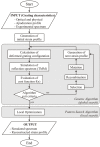Review of Chirped Fiber Bragg Grating (CFBG) Fiber-Optic Sensors and Their Applications
- PMID: 29973516
- PMCID: PMC6068677
- DOI: 10.3390/s18072147
Review of Chirped Fiber Bragg Grating (CFBG) Fiber-Optic Sensors and Their Applications
Abstract
Fiber Bragg Gratings (FBGs) are one of the most popular technology within fiber-optic sensors, and they allow the measurement of mechanical, thermal, and physical parameters. In recent years, a strong emphasis has been placed on the fabrication and application of chirped FBGs (CFBGs), which are characterized by a non-uniform modulation of the refractive index within the core of an optical fiber. A CFBG behaves as a cascade of FBGs, each one reflecting a narrow spectrum that depends on temperature and/or strain. The key characteristic of CFBGs is that their reflection spectrum depends on the strain/temperature observed in each section of the grating; thus, they enable a short-length distributed sensing, whereas it is possible to detect spatially resolved variations of temperature or strain with resolution on the order of a millimeter over the grating length. Based on this premise, CFBGs have found important applications in healthcare, mechanical engineering, and shock waves analysis, among others. This work reviews the present and emerging trends in CFBG sensors, focusing on all aspects of the sensing element and outlining the application case scenarios for which CFBG sensors have been demonstrated.
Keywords: Chirped Fiber Bragg Grating (CFBG); FBG sensors; Fiber Bragg Grating (FBG); fiber optic sensors; photosensitivity.
Conflict of interest statement
The author declares no conflict of interest.
Figures














Similar articles
-
Ultrafast Fiber Bragg Grating Interrogation for Sensing in Detonation and Shock Wave Experiments.Sensors (Basel). 2017 Jan 27;17(2):248. doi: 10.3390/s17020248. Sensors (Basel). 2017. PMID: 28134819 Free PMC article.
-
A Highly Sensitive Two-Dimensional Inclinometer Based on Two Etched Chirped-Fiber-Grating Arrays.Sensors (Basel). 2017 Dec 15;17(12):2922. doi: 10.3390/s17122922. Sensors (Basel). 2017. PMID: 29244770 Free PMC article.
-
Optically tunable chirped fiber Bragg grating.Opt Express. 2012 May 7;20(10):10827-32. doi: 10.1364/OE.20.010827. Opt Express. 2012. PMID: 22565706
-
Review and Analysis of Peak Tracking Techniques for Fiber Bragg Grating Sensors.Sensors (Basel). 2017 Oct 17;17(10):2368. doi: 10.3390/s17102368. Sensors (Basel). 2017. PMID: 29039804 Free PMC article. Review.
-
Fiber Bragg Grating Sensors for the Oil Industry.Sensors (Basel). 2017 Feb 23;17(3):429. doi: 10.3390/s17030429. Sensors (Basel). 2017. PMID: 28241460 Free PMC article. Review.
Cited by
-
Shallow-Tapered Chirped Fiber Bragg Grating Sensors for Dual Refractive Index and Temperature Sensing.Sensors (Basel). 2021 May 24;21(11):3635. doi: 10.3390/s21113635. Sensors (Basel). 2021. PMID: 34073669 Free PMC article.
-
Highly Dense FBG Temperature Sensor Assisted with Deep Learning Algorithms.Sensors (Basel). 2021 Sep 15;21(18):6188. doi: 10.3390/s21186188. Sensors (Basel). 2021. PMID: 34577392 Free PMC article.
-
Fiber Bragg Grating Sensor Networks Enhance the In Situ Real-Time Monitoring Capabilities of MLI Thermal Blankets for Space Applications.Micromachines (Basel). 2023 Apr 25;14(5):926. doi: 10.3390/mi14050926. Micromachines (Basel). 2023. PMID: 37241550 Free PMC article.
-
Post-gel polymerisation shrinkage profiling of polymer biomaterials using a chirped fibre Bragg grating.Sci Rep. 2021 Jan 14;11(1):1410. doi: 10.1038/s41598-020-80838-5. Sci Rep. 2021. PMID: 33446736 Free PMC article.
-
Monitoring tissue temperature during photothermal therapy for cancer.J BioX Res. 2019 Dec;2(4):159-168. doi: 10.1097/jbr.0000000000000050. J BioX Res. 2019. PMID: 33088609 Free PMC article.
References
-
- Udd E., Spillman W.B. Fiber Optic Sensors: An Introduction for Engineers and Scientists. 2nd ed. Wiley; Hoboken, NJ, USA: 2011.
-
- Rao Y.J. In-fibre Bragg grating sensors. Meas. Sci. Technol. 1997;8:355–375. doi: 10.1088/0957-0233/8/4/002. - DOI
-
- Kersey A.D., Davis M.A., Patrick H.J., LeBlanc M., Koo K.P., Askins C.G., Putnam M.A., Friebele E.J. Fiber grating sensors. J. Lightwave Technol. 1997;15:1442–1463. doi: 10.1109/50.618377. - DOI
Publication types
LinkOut - more resources
Full Text Sources
Other Literature Sources

